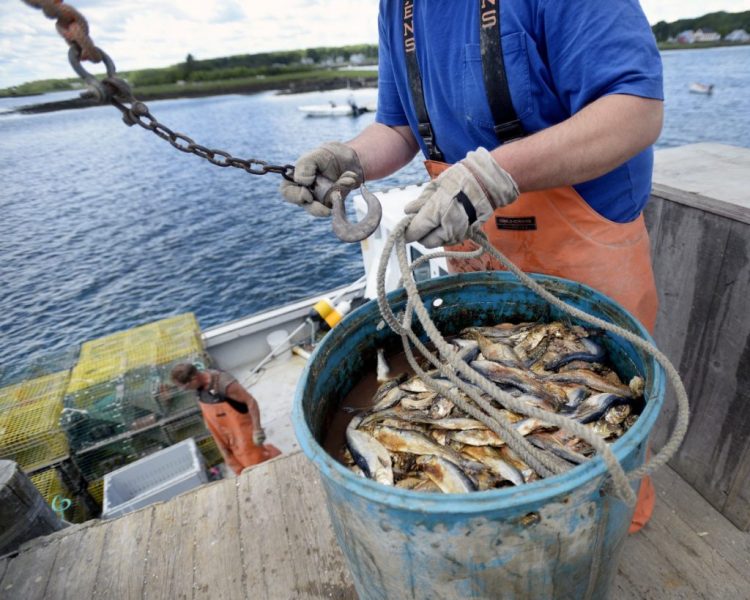Maine unlocked access to more lobster bait Monday with the reopening of the menhaden fishery, easing the lobster industry’s anxiety about a looming bait shortage as peak summer season kicks into high gear.
The state ordered its menhaden fleet to stop fishing on June 30 after officials concluded it had exceeded the state’s annual quota of 2.4 million pounds by 1.5 million pounds, the majority of which was landed in the last four days of June, according to state records.
But menhaden, a schooling forage fish also called pogy, were still abundant in Maine waters from Kittery to Penobscot Bay, so Maine sought access to another 4.7 million pounds of quota that is set aside for New England states to share when they catch their limit but the fish remains in large numbers.

Mitch Nunan prepares to load herring onto his lobster boat in Cape Porpoise in 2017. Maine’s lobster industry is facing the threat of a severe bait shortage, with limits on the herring catch. On Monday, regulators approved an increase in the amount of pogy, an alternative bait fish, that can be caught for this season. Shawn Patrick Ouellette/Staff Photogrpaher
Last week, regional fishing managers approved Maine’s request despite some reports that harvesters had dumped their menhaden overboard, with dead fish ending up in the coves, because the fleet couldn’t find buyers early in the season.
The cold, wet spring delayed the start of the lobster season this year. The traditional July molt had been creeping up into June as ocean temperatures in the Gulf of Maine grew warmer over the past few years, but chilly waters this year pushed the shed back to its traditional July timeline.
State officials hope landing the extra menhaden quota now that peak lobster season has started and bait demand is picking up will help ease fears of a shortage predicted as a result of a 70 percent reduction of landings for herring, Maine’s most popular lobster bait.
Maine’s $485 million a year lobster industry relies on the availability of affordable bait to lure shedding lobsters into their traps. Those who fish out of smaller ports worry about bait availability, but almost everybody worries about what a shortage could mean for bait prices.
Swans Island fishermen, for example, are paying $80 a bushel for herring at some docks, according to veteran lobsterman Jason Joyce. Last summer a typical price for a bushel of herring was $45. Just the possibility of a bait shortage can drive up the price of herring as well as alternative baits.
The late molt – which is the time when the lobsters shed their old shells, grow a bigger soft one and move inshore – means many Maine lobstermen have just recently set their full allotment of traps, which is 800 across most parts of the state. Having fewer traps in the water has kept demand for bait relatively low.
“For now, I imagine a lot of the bait coolers are pretty full,” said lobsterman Jeff Putnam of Chebeague Island. “The best-case scenario would be that lobstermen start using more bait when the catch picks up and Maine gets more pogy quota at that time to keep up with demand.”
But menhaden alone will not solve the industry’s bait problem once the lobster fishery hits its peak stride. Even if Maine catches all of the extra menhaden quota, that only equals 7.1 million pounds of bait.
Last year, the Maine Lobstermen’s Association was predicting a 50 million-pound bait shortage in 2019.
To close that gap, the Maine Department of Marine Resources is reviewing new bait sources. In Maine, a lobsterman must use approved baits. With the shortage looming, the state has added several new sources, including Gulf menhaden and blackbelly rosefish, and is considering others, including Asian carp.
Menhaden helped Maine close its lobster bait gap last year, too. In 2018, the state fleet landed almost 7 million pounds of menhaden, including the full regular season quota and a bonus set aside for New England. Maine’s 2018 menhaden harvest was twice its 2017 catch.
Last year, Maine needed only three weeks to land almost all of the extra New England-wide quota.
Part of the high catch rate comes from the size of the fleet. In past years, only a handful of fishing vessels have entered Maine’s regular pogy fishery. Last year, however, the fishery drew 50 fishing vessels during the regular season and 64 in the special bonus fishery.
This year, more than 100 boats have gotten permission to fish for Maine’s extra menhaden quota.
The additional quota is not enough for a fisherman to make a living off menhaden, even with the herring shortage driving up all bait prices, but it can land extra income for local fishermen, including lobstermen, who rig up their boats and participate in this traditional purse seine fishery.
Send questions/comments to the editors.




Success. Please wait for the page to reload. If the page does not reload within 5 seconds, please refresh the page.
Enter your email and password to access comments.
Hi, to comment on stories you must . This profile is in addition to your subscription and website login.
Already have a commenting profile? .
Invalid username/password.
Please check your email to confirm and complete your registration.
Only subscribers are eligible to post comments. Please subscribe or login first for digital access. Here’s why.
Use the form below to reset your password. When you've submitted your account email, we will send an email with a reset code.